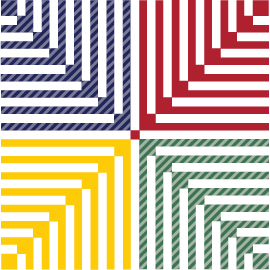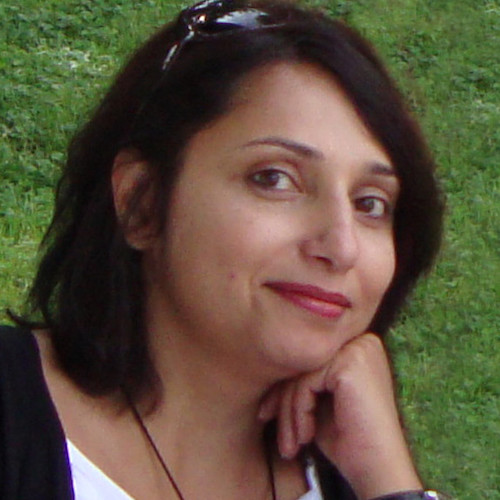Azza El-Hassan is a Palestinian filmmaker on a quest: She wants to retrieve the lost/confiscated Palestinian narrative and visual history. She has been on this quest for nearly two decades, at least since she made her film Kings and Extras in 2003-4. She is the Restoration Director for two films that she retrieved: Jerusalem, Flower of All Cities and Palestine in the Eye. Both are screening as part of the program on Cinema of the Palestinian Revolution at the Harvard Law School as part of this year’s festival. El-Hassan is also an Artistic Consultant for Creative Interruptions, under whose auspices the restorations were done. We spoke to her to learn more about her work and its broader context.
BPFF: How did this retrieval and restoration effort all start?
AH: A long time ago in 2003, I made a film called Kings and Extras. In that film, I set out on a journey in search of the lost film archives. These archives belonged to the PLO’s Palestine Film Institute in Lebanon. After Israel invaded Beirut in 1982 and destroyed the Institute, the fate of these films was unknown. Back then, I decided to search for them. In 2004, Kings and Extras came out. I could not find any of the missing films, so it ended up more a reflective piece. That film is very close to my heart, because I was making a new archive.
But this project never left me. Israel has been destroying and looting Palestinian archives since the 1930s. The Tel-Aviv Library confiscated tens of thousands of Palestinian books during the Nakba, and the Israeli military archive holds PLO films—a fact that makes you feel violated. The Israelis not only seized our homes and lands; they also seized our photos, films, and our narrative about our lives and our heritage. As a filmmaker, this has always troubled me. My protagonists’ pasts were hijacked, so I could not place my characters in a visual historical context, and the proof of the authenticity of their narratives was gone.
Through my work, I decided that I wanted to see if, when Palestinians flee from one place to another, they carry their relatives’ films with them. Not the filmmakers themselves, because we know they carry their films. For example, Nadiha Lutfi is a Lebanese filmmaker who was part of the Palestine Film Institute. Before the Israeli army entered, she went into the Institute and took her film, called Because Roots Don’t Die. And it was recently restored by a French Institute, although she died before it was completed and her son Yasser Moktar completed her work. So my question was, when filmmakers are no longer there, do their family members carry their films with them?
When I made Kings and Extras, I asked Hiba Jawharieh, the daughter of Hani Jawharieh,* this question, but she did not know. Fourteen years later, I asked her again, and the family searched and found the films in August 2017 in their attic. Hiba’s mother had carried these films, because her father [Jawharieh] was killed in 1976, and the Israeli Invasion of Lebanon happened in 1982. Her mother carried them from Lebanon to Jordan and kept them in the attic. There were three cans of film reels, which I brought back to London.
We began the work of restoring the films through the Creative Interruptions project at Sheffield Hallam University in the UK. Through this platform, as a filmmaker, I restored two films, Jerusalam, Flower of All Cities, by Ali Siam, and Palestine in the Eye, by Mustafa Abu Ali. When I opened the three cans, I discovered that one was empty. It was the can Jawharieh was going to film when he got killed, and he never did. And his wife carried it around all those years, thinking there was a film on it.
One of the other two films was Jerusalem, The Flower of all Cities. I believe this is the first Arab video music clip ever made. At that time, the Arab world was not yet making music videos, and this song really mobilized Arab sentiment towards the occupation of Jerusalem. I love the film opening, because it is addressing all the Arabs all over the world. It was produced by the Jordanian Ministry of Culture. The interesting thing is that when Hani Jawahrieh joined the PLO and decided to move to Lebanon, he took his copy of that film with him. Hani originally comes from Jerusalem. So it is quite amazing to see how he filmed his city. After that, his city was occupied, and he left and he joined the PLO. It became forbidden ground; he could no longer return. In the beginning of the film, you see all these lively shots of the city. Then, you start to see repeats—as if he can no longer go back to his city. Those first few shots are all he has; he must repeat. I love this film; it is very tender.
Palestine in the Eye tells the tale of a Palestinian cameraman [Hani Jawahrieh] who cared about something and was killed. It shows how Palestinians at that time saw themselves in relation to America. And I find it to be a very special film, because it contains the last moments when Hani was shot as he was filming.
I learned about Glow of Memories and The Urgent Call during my research on Palestinian films and attempts to retrieve these films I called Bashar Shammout, who is the son of the famous Palestinian painter and filmmaker, Ismail Shammout. I knew Bashar from my childhood, but I didn’t think that he would suddenly say, as he did, “But I have two of my father’s films.” It was like finding a huge treasure.
Again, we invited Bashar to Creative Interruptions to work on restoring his father’s two films. Glow of Memories shows an artist at work who is experimenting with a new medium, film. It is gorgeous. I love this film—it is my favorite.
The Urgent Call of Palestine gives you deep insight into how the Palestine liberation movement saw itself. The urgent call was to liberate, not only Palestinians, but also Jews. It was gorgeous. And Ismail Shammout, the director, does this dramatic pause in the film. When Kamal Nasser—a writer, a poet, and a political leader—states that the urgent call of Palestine is to fight for Palestinian refugees to return to their land and how they “the Palestinian Liberation Movement” want to liberate Palestinians and Jews from the aggression of Zionism, the director then pauses to write on the screen that Kamal Nasser was subsequently assassinated. The film is telling you that Zionism is attacking not only Palestinians but also Jews. Zionism wants to silence them both to censor the truth.
Palestinian Identity was made by Kassem Hawal. Of the films included in your program, this is the only one whose filmmaker who is alive. He is an Iraqi who worked closely with the Palestinian Film Institute which produced this film. Hawal is alive and he has a collection of films. He lives in Amsterdam. I had nothing to do with that film, however.
I think it is very important that these films come out on the seventieth anniversary of the Nakba. The Israeli occupation is not just about land, but also about occupying everything that you know and tell others about yourself. They’ve even occupied our story—seizing it, censoring it.
BPFF: Tell us more about the film archive that existed in Beirut. What types of assets and materials did it hold? How did it get started?
AH: The Palestine Film Unit (later the Palestine Cinema Institute) was linked to the PLO. It was founded in 1969 in Jordan by a woman named Sulafa Jadallah, the first woman in the Arab world to graduate from the Higher Cinema School in Egypt. She is hardly ever mentioned. Very few people know that she actually founded it. In Jordan at that time, lots of young Palestinian men were getting killed, and she wanted to document this. From there, the Idea started developing. The main interest was to document Palestinian reality and to tell the world about Palestine. After it was founded, it started attracting left-wing filmmakers from all over the world—Iraqi, Lebanese, Egyptian—people like Jean Luc Godard and Jean Genet. It attracted lots of people who wanted to be part of what they saw as a special thing developing in film. There are also very nice aspects to this. For example, if you watch at Palestine in the Eye, at the end, when the credits roll, you will see, “This film is made by the following workers.” They saw themselves as workers for a cause, not artists owning a piece of art but workers who were working together on a movement.
The Palestine Cinema Institute was an extremely valuable and special thing. I remember I interviewed Khadijeh Khabajneh, the archivist. They would take the films and screen them to the refugees. Watching the films, the refugees’ facial expressions transformed from those of helpless victims—they became inspired. They were producing propaganda, but nice propaganda. It made people happy to see themselves in a different way.
They were propaganda films but they were also representing a sentiment and a feeling at that time—that we are not victims. This was contrary to an image of victimhood that developed later. They wanted to perceive themselves as fighters and liberators of the whole world.
In 1982, what happened to the Palestine Cinema Institute is that the staff moved all the films and collections to a warehouse, switched on the air conditioning, and then left. With an invasion imminent, they could not stay. But it seems that there are lot films yet to be found. I think we will find more in private collections.
BPFF: If someone finds such a film, what should they do?
There is now a fever of archiving. Many Palestinians are starting this. There are many Palestinian institutions where such things can be deposited.
BPFF: What happened to the Palestinian Cinema Institute in the end, after 1982?
The end of the story was a mystery; this comes out in my film Kings and Extras. There were five different possible theories: It was burned; the Israelis took it; it was buried in a graveyard. The truth is, I personally believe that the Israelis took most of the archive, but that some of it was also looted and some destroyed. This is just out of my research and the fragments I have found. People took some of the films, with them as they left. Since then, no such institute represented Palestinian cinema until very recently. For example, Film Lab Palestine was founded in Ramallah in 2014 to further document the collective Palestinian memory as well as the unique individual voices of Palestinians within the occupied territories and abroad. And I even think they have re-established, only this year, something called the Palestine Film Institute.
So Palestinian cultural production went through several stages. First, in the wake of the Nakba, there was a void. Then from 1969 to 1982, there was the Palestinian Film Unit that later became the Palestine Cinema Institute. After Israeli invaded Beirut in 1982 and drove the PLO out, with the collapse of the Institute and the end of the golden age of the PLO, you had the rise of independent filmmaking, with work produced by Michel Khleifeh, Elia Suleiman etc. Then with the Oslo Accords in 1993-95, there was yet another wave characterized by coproduction with the West, which was a continuation of the second wave. So the collapse of the Institute signaled a major shift: Films became an individual effort rather than a national effort.
BPFF: What kind of condition were the films in when you found them?
AH: Restoring these films was a major effort. Sometimes you could hardly see the image. Like in Palestine in the Eye, I could hear the bell ringing but not see it. As the image started to improve, suddenly I could see not only the bell but also people, as if people were suddenly were coming to life.
BPFF: What is entailed in the actual restoration process?
AH: Now with digital technology, it is easier. You copy the film onto a digital medium and you work with the colors and the image. First you enhance the colors, and if there is something wrong with the image, you try to fix it. The process involves graphics, color correction, filtering the sound again, and so on. You end up working on them frame by frame. You have lot of drops in the image and lots of dirt.
We could have made it look brand new. I took the decision that this is not the image I wanted. These are archival films, and you need to maintain their integrity. The decision was to maintain the integrity of the films as archival films—not to over-restore them but rather to make them available to the eye so you can see the details in the image. I tried to maintain what is there.
BPFF: Why do you think we are seeing an increase in Palestinian cultural projects at this particular historical juncture?
AH: There is a very big debate among Palestinians that because the political discourse is failing so markedly, people are reverting to culture. Through culture, you can at least say, “I exist”—when you have an image, a language, and art. It is a form of resistance. But it is also reflective of the collapse of everything else.
I see my work where I retrieved these films to be an act of Palestinians reclaiming their collective narrative. The work of archiving in a context of attempted erasure takes on a totally different meaning than it normally would. By restoring these films at this time—the work done by myself, Bashar, and Kassem—the films are not merely historic documents; they are saying “we exist.”
BPFF: What are you working on next?
AH: I am doing my PhD on the effect of the void of visual materials on Palestinian narrative. I am looking at my work and working on a documentary. The retrieval of these films is part of my research. I am working on a film called My Mother and Other Revolutionary Matters. I am trying to tell the story of my own mother, whom I lost to cancer a few years ago. My mother was a revolutionary in her own right. The film explores how the public narrative of Palestine invades people’s private narratives and lives. There is nothing private; there is only politics.
BPFF: Thank you for speaking with us today.
* Hani Jawharieh was a Palestinian filmmaker and cinematographer. Born in Jerusalem in 1939, Jawharieh studied cinematography at the London Film School from 1964-1966. After the 1967 war, together with Sulafa Jadallah and Mustafa Abu Ali, he established the PLO’s Palestine Film Unit, which was considered the filmic arm of the Palestinian revolution. Jawharieh filmed many films, and his images were considered the face of the revolution. He was killed on April 11, 1976 by a shell while filming in the Aintoura Mountains in Lebanon.
The Cinema of the Palestinian Revolution program screens Wednesday, October 24, 2018 at 6 pm at the Harvard Law School. Dr. Kamran Rastegar, the Guest Speaker, will be in conversation following the film.
Free and open to the public. Co-presented with Creative Interruptions.
View the full festival schedule here.


